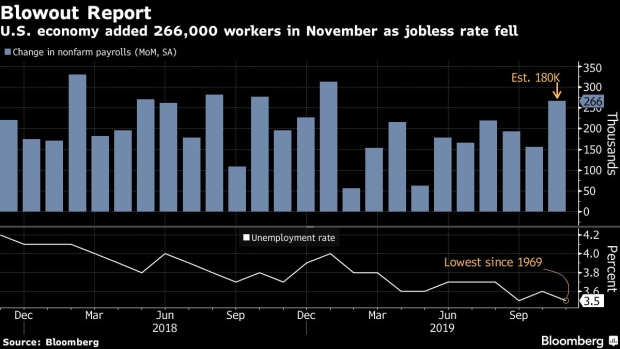Dec 31, 2020
2020 U.S. Economy Field Guide: Five Key Things to Watch
, Bloomberg News

(Bloomberg) -- As a new decade dawns, some -- but not all -- of the dark clouds hanging over the U.S. economy have cleared.
If anything, 2019 was a year on the edge: It started with a government shutdown, then fears of recession dominated for months as the trade war with China intensified. That battle hurt business investment and threatened the economic expansion, which nevertheless became the country’s longest on record at midyear -- thanks to nonplussed Americans who kept on spending.
The strength was fueled by job gains that unexpectedly picked up steam late in the year, bucking forecasts for a slowdown. Downside risks have eased somewhat as the Federal Reserve lowered interest rates three times, U.S.-China tensions cooled and the U.K. election removed some of the Brexit uncertainty that’s haunted the global economy.
It doesn’t necessarily mean growth will enjoy a resurgence, though. Economists still expect a slowdown to about 1.8% for gross domestic product growth in 2020, which is around what most analysts see as the long-run potential rate but well short of the 3% that President Donald Trump pledged to achieve.
In addition, the trade war with China is far from over, corporate debt is piling up, global growth remains sluggish and Boeing Co.’s production halt on the troubled 737 Max jet will ripple through factories.
Here are five key trends in the U.S. economy to watch in 2020:
Labor Step-Down
The job market outperformed projections at the tail end of the year, with unemployment matching a half-century low and wages picking up -- particularly among the average, non-supervisory worker where gains are approaching 4%. A strong payroll gain of 266,000 in November was enough to undermine projections that things were shifting into lower gear.
That narrative could weaken a bit with payroll revisions due in February that will make the past look less shiny. And analysts reckon that the downshift will still come in 2020, with average monthly job gains slipping in the third quarter, as the pool of available workers shrinks further.
That suggests 2020 will be the year when the Phillips Curve is really put to the test: Will wage gains accelerate and finally push inflation higher?
Consumer Engine
Even if it cools a bit, the labor market alone is likely to continue sustaining spending on goods and services -- the economy’s lifeblood -- as well as in housing.
The real estate sector in particular is primed for a stronger 2020 -- thanks to lower interest rates -- after a dismal 2018 and yawn-inducing 2019. Builders and consumers are optimistic, permits are rising and there’s plenty of pent-up demand. Yet supplies may continue to be thin amid constraints like restrictive zoning regulations and baby boomers staying in their homes.
Factory Flatline?
While the manufacturing sector appears to be emerging from its contraction that lasted two quarters in 2019, it’s not about to go gangbusters. For one, demand may take some time to recover following the China trade truce, and companies could remain wary until a more comprehensive agreement is reached.
In addition, the strong dollar will continue to weigh on exports. With manufacturers eyeing a pullback in spending next year for the first time since 2009, their health will potentially hold back growth from being more robust.
Shaky States
While the national-level data may remain solid, states could run hot or cold. What happens in local economies is key for the 2020 presidential election, given how narrow victories in a few swing states helped deliver Trump’s win in 2016.
That means factory-job numbers in places like Michigan, Pennsylvania and Wisconsin are likely to get outsize attention following conflicting data in 2019. And changing demographics along with an influx of transplants in once-reliable Republican strongholds like Texas is making things less predictable in other places as well.
Read more: A look at the economies of the early voting states
Risk Picture
Risks lurk in the shadows of a 2020 outlook for steady growth. Debt is one of them: Former Fed officials are among those warning of dangers of a prolonged period of easy policy, which can increase investors’ appetite for riskier and higher-yielding assets.
There’s also the possibility of a re-escalation in the trade war with China along with continued sluggishness in the global economy and weakness in business investment.
Another potential risk is that wage gains could accelerate more forcefully and finally feed through to inflation, putting pressure on the Fed to raise rates.
To contact the reporter on this story: Katia Dmitrieva in Washington at edmitrieva1@bloomberg.net
To contact the editors responsible for this story: Scott Lanman at slanman@bloomberg.net, Jeff Kearns
©2019 Bloomberg L.P.







